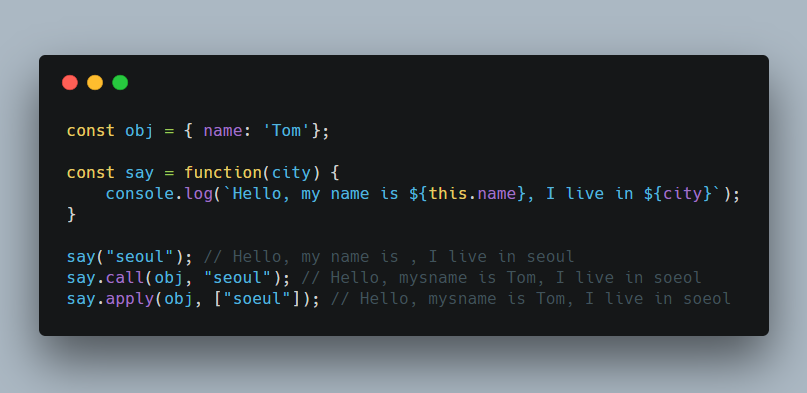
바인딩이란?
함수 호출과 실제 함수를 연결하는 방법
function add(x, y){
this.val = x + y;
console.log(this.val)
}
let obj = {val:0};
let boundFn = add.bind(obj, 2, 8);
boundFn() // 10-
위 코드는 this값을 바인딩하는 모습이다.
-
this의 값에 obj를 바인딩해서 실제 함수를 연결한다.
[apply&call]
기본문법
var example = function (a, b, c) {
return a + b + c;
};
example(1, 2, 3);
example.call(null, 1, 2, 3);
example.apply(null, [1, 2, 3]);-
call은 보통 함수와 똑같이 인자를 넣고, apply는 인자를 하나로 묶어 배열로 만들어 넣는 것을 알 수 있다.
-
배열이 아닌 유사배열은 배열이 아니기 때문에 배열의 메소드를 쑬 수 없다. 이때 call이나 apply가 효력을 발휘한다.
-
null인자는 this를 대체한다.
var obj = {
string: 'zero',
yell: function() {
alert(this.string);
}
};
var obj2 = {
string: 'what?'
};
obj.yell(); // 'zero';
obj.yell.call(obj2); // 'what?'prototype 기능 빌려쓰기
- 주체가 되는 instance와 method의 순서를 바꿀 수 있다.
function moreThanFive(element) {
return element.length > 5;
}
let arr = ["code", "states"];
arr.filter(moreThanFive); // ["states"]
Array.prototype.filter.call(arr, moreThanFive); //["states"]-
위의 코드에서 인스턴스인 arr이 먼저등장해서 뒤에 filter메소드를 적용한 방법과 this등 바인딩이 필요한 경우에 사용할 수 있는 call문법이 순서가 반대인것을 확인 할 수 있다.
-
이러한 방법으로 유사배열에 call과 apply를 적용하면 배열메소드를 적용할 수 있다.
[bind]
-
bind함수가 call, apply와 다른 점은 함수를 실행하지 않는다는 점
-
대신 bound함수를 리턴
[bind로 커링 구현하기]
Currying은 여러 개의 인자를 가진 함수를 호출 할 경우, 파라미터의 수보다 적은 수의 파라미터를 인자로 받으면 누락된 파라미터를 인자로 받는 기법
function curring(num) {
return function(add) {
return num + add;
};
}
var add = curring(5);
var result = add(5);
console.log(result);- 위의 코드가 커링의 기본예제이다.
function template(name, money){
return "<h1>" + name + "</h1><span>" + money + "</span>";
}
let tmplSteve = template.bind(null, "Steve");
tmplSteve(100); //<h1>Steve</h1><span>100</span>- this의 값이 필요없으니 null로 적어주고 이름을 입력값으로 넣고 tmplSteve변수에 담아준다. 변수는 money변수를 변경하면서 재사용이 가능해진다.
[바인드의 특별한 case]
setTimeout
function Box(w, h){
this.width = w;
this.heigth = h;
this.getArea = function(){
return this.width * this.heigth;
}
this.printArea = function(){
console.log(this.getArea());
}
}
let b = new Box(100, 50);
b.printArea(); // 5000- 위 코드는 this의 값이 new 연산자로 인해 바인딩된 모습이다.
setTimeout(b.printArea, 2000); - setTimeout에 적용하면 작동이 날까? 콘솔에서 확인해보면 this의 값은 window객체로 변경되어 있다.
기본적으로 setTimeout의 경우 인자로 넘기는 함수의 this값이 window객체로 바인딩된다고 mdn문서에서 확인된다. 기본 값이 이렇게 지정되어 있는 경우에는 어떻게 해야할까?
setTimeout(b.printArea.bind(b), 2000); - 다시 한번더 명시적으로 바인딩을 지정하면 된다.
